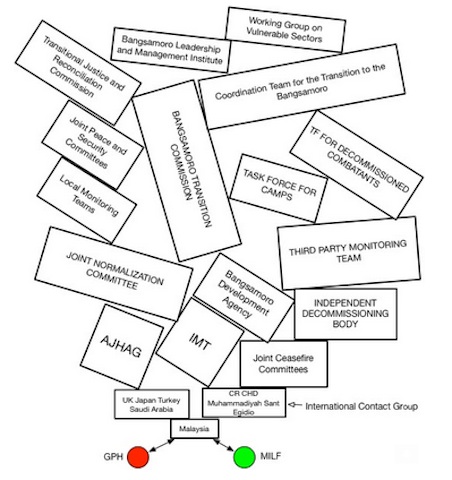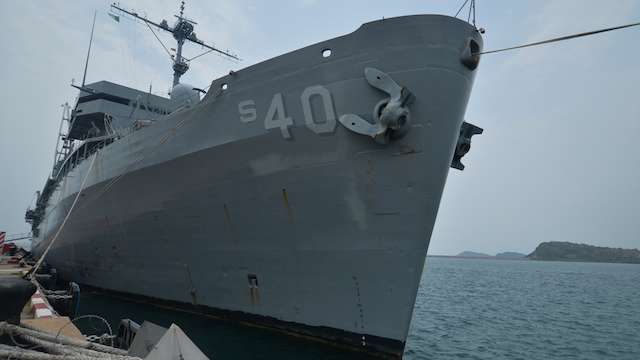From the Philippine News Agency (Jun 12):
Acquisition of BRP Gregorio Velasquez highlights PHL gov't aim to modernize AFP
The decision to acquire BRP Gregorio Velasquez (AGR-702),
the country's first survey ship, highlights the resolve of the national
leadership to modernize and upgrade the capabilities of the Armed Forces of the
Philippines (AFP).
This was stressed by Defense Secretary Voltaire Gazmin's
speech, read by defense undersecretary Honorio Azcueta, during the arrival and
welcoming ceremonies for the ship last at Pier 13, Manila South Harbor last
June 10.
"The Philippine Navy (PN)'s acquisition of the BRP
Gregorio Velasquez, the former USNS Melville is a statement to the firm resolve
and determination of our national leadership to modernize and upgrade the
capabilities of our Armed Forces," he added.
BRP Gregorio Velasquez was one of the two US ships pledged by US President Barack Obama to
the PN during the APEC Leaders' Summit in Manila last November.
The other vessel is the ex-USCGC Boutwell (WHEC-719) which
is scheduled to be delivered later this year.
"We should thank the strong support of President Aquino
to pursue the AFP Modernization and Capability Upgrade Program that since July
2010 to date has caused the release of PHP60.14 billion from the meager
resources of our government to support the said program," Gazmin stressed.
The BRP Gregorio Velasquez will give the PN the capability
for hydrographic and oceanographic survey.
"The ship will provide the PN the capability for
hydrographic and oceanographic survey and will also become a platform for
inter-agency collaboration partners from the academe and thus improve awareness
of our sub-surface environment," PN spokesperson Capt. Lued Lincuna
earlier said.
The ship can also perform search-and-retrieval operations
and support to humanitarian assistance and disaster relief operations.
BRP Gregorio Velasquez left Guam by June 2 and arrived in Manila Bay
at 11:00 a.m. last June 8.
The ship arrived in Guam
last May 28. She left San Diego, California last April 27
after being formally transferred to the PN.
The BRP Gregorio Velasquez is commanded by Cmdr. Edwin Nera.
The ship is presently manned by 30 officers and enlisted personnel.
Aside from helping map the country's vast maritime domains,
the BRP Gregorio Velasquez (formerly the US research vessel Melville) will
also help develop the PN's anti-submarine warfare (ASW) capability.
"Aside from its primary mission, AGR-702 would also be
a valuable platform in reviewing our anti-submarine warfare capability,"
he said.
Lincuna did not give specifics on this but the PN is in the
process of developing its ASW capability after signing a contract to acquire
two AW-159 "Wildcat" anti-submarine helicopters with AgustaWestland
last March.
The contract is worth PHP5.360 billion, lower than the
stated PHP5.4 billion.
These helicopters are expected to be deployed among the PN's
large ships which include the two Gregorio Del Pilar-class frigates and
incoming two strategic sealift vessels, of which one is expected to be
delivered this month, and the BRP Gregorio Velasquez.
Lincuna said the acquisition of the latter ship also aims to
address the issues in terms of marine scientific researches/surveys and to
gather marine scientific data beneficial to naval operations.
"Also, said vessel will enhance capacity and build
capability to support the environmental protection efforts and exploration of
the country for economic purpose," he added.
She is the country's first oceanographic research vessel.
The BRP Gregorio Velasquez is being manned by a crew of 50
Filipino officers and enlisted personnel who have undergone familiarization and
orientation training on various systems of the ship since last March.
Lincuna said the research vessel will not only provide the
PN capability for hydrographic survey but platform for inter-agency
collaboration for partners in the academe and thus improve awareness of the
Philippine sub-surface environment.
Per policy, auxiliary research vessels are to be named after
national scientists, hence her namesake, Dr. Gregorio Velasquez, a pioneer in
Philippine physiology.
Velasquez was elected as academician on 1978 and conferred
as National Scientist on 1982.
He was conferred with a Distinguished Science Medal and
Diploma of Honor from the Republic of the Philippines (1956), the John Simon
Guggenheim Memorial Foundation Fellowship (1956-57), Men of Science, Division
of Biological Sciences in1969, World's Who's Who in Sciences in 1970 and the
Republic of the Philippines Cultural Heritage award in 1972.
http://www.pna.gov.ph/index.php?idn=1&sid=&nid=1&rid=894270


 Illustration courtesy of Bong Montesa
Illustration courtesy of Bong Montesa